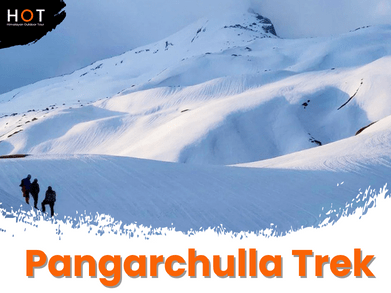Kedarkantha, a thrilling summit trek ideal for beginners, is near Govind Pashu Vihar National Park in Uttarakhand. Rising to an altitude of 3810 meters, the summit offers breathtaking 360-degree views of some of the most famous Himalayan peaks, including the Swargarohini, Bandarpoonch, Black Peak, and Ranglana in the Yamunotri and Gangotri ranges. Part of the trek’s appeal is the ascent to the summit, which begins in the early morning with chilly temperatures and headlamps illuminating the path under a dazzling dawn. The trails of Kedarkantha combine all the subtleties and difficulties of a summit experience, but on a much smaller scale.
This trek, which covers a distance of over 20 km over five days, is ideal for novice hikers due to the short daily mileage. The trek starts in Sankri village, which is the starting point for many treks in Uttarakhand. From Sankri, the trail passes through dense forests of maple and oak trees, crosses several wooden bridges, and comes to the first campsite, Juda-ka-Taal. The following day, the trek gradient increases as we head towards the 4 km-distant Kedarkantha Base Camp. The trail winds through dense oak forests that open up to several clearings along the route.
Look out for the abundant flora and fauna, which includes Black Eagle, Golden Eagle, and Rhododendron trees, among many others. The Kedarkantha Base Camp provides breathtaking 180-degree views of high snow-capped ranges such as Bandarpoonch, Swargarohini, and Kalanag. The snow-covered Kedarkantha Peak also appears closer from this location, shining brighter than the moon on most nights. The trek to the summit the next day is an incredible experience, with a steep ascent, strong winds, and frigid temperatures during the winter months making this the most difficult part of the Kedarkantha trek. Click here to learn more about the terrain, the necessary skills, and the equipment needed to accomplish the Kedarkantha trek.
This trek’s wholesome experience is what makes it an adventure haven. Snow-covered landscapes, towering oak and pine trees, and camping next to a picturesque high-altitude lake are just a few of the trek’s highlights; you can read more about them here. December to February is the best time to undertake the Kedarkantha Trek (for snow). This page has all the information you need, including the route map, temperature, weather, photos, videos, and reviews. Scroll down to read the Kedarkantha Trek blogs.
Trip Overview
Day 1: Arrive in Sankri (1950 m)
Day 2: Sankri to Juda-ka-Taal (2773 m)
Day 3: Juda-ka-Taal to Kedarkantha BC (3413 m)
Day 4: Kedarkantha BC to Summit (3810 m) & back to Hargaon (2700 m)
Day 5: Hargaon campsite to Sankri (1950 m); Depart from Sankri













